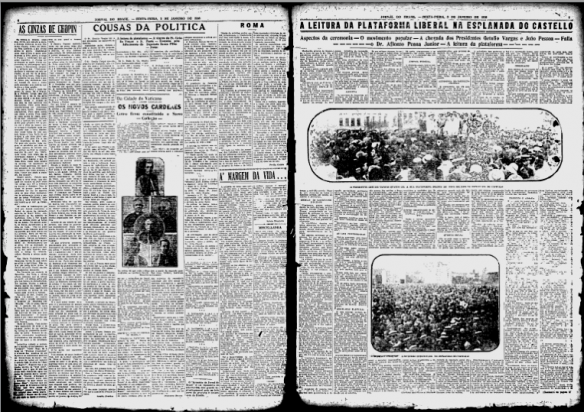
CO
Quando um microfilme se torna repulsivo
A week or two ago, I made it back to the Biblioteca Nacional for the first time in over a month. The reason for the delay was the perfect combination of my research lethargy and the fact that the library employees, bless their souls, went on an extraordinarily prolonged strike (which appeared to go unnoticed by nearly everyone except the workers themselves and a handful of very frustrated researchers). Ah, but all good things (excuses for not having made more JP progress) must come to an end, and so did the strike. So one Friday morning I dragged myself onto the Metro, rolled up my sleeves, and started threading in the microfilm. 1928, ready or not, here I come.
É sua primeira vez no blog? Leia antes o post “Uma Introdução” (em português).*
A week or two ago, I made it back to the Biblioteca Nacional for the first time in over a month. The reason for the delay was the perfect combination of my research lethargy and the fact that the library employees, bless their souls, went on an extraordinarily prolonged strike (which appeared to go unnoticed by nearly everyone except the workers themselves and a handful of very frustrated researchers). Ah, but all good things (excuses for not having made more JP progress) must come to an end, and so did the strike. So one Friday morning I dragged myself onto the Metro, rolled up my sleeves, and started threading in the microfilm. 1928, ready or not, here I come.
Now, the Rio de Janeiro of the Correio da Manhã in 1928 is the most blood-spattered, tragic, despairing city I have ever seen. You’ll think that I’m exaggerating. And that is a good guess, because I generally am. But in this case, you can take me at my word. The Correio da Manhã, back in the day, looked pretty much like this:
 Light reading.
Light reading.That’s the Jornal do Brasil in the image, because no-one has bothered to archive the now-defunct Correio da Manhã in Google News, but you get the point. The Correio da Manhã has even less pictures; it’s a massive neverending block of text, little news item upon little news item. And I would say that 40% of those news items – and I wasn’t keeping scrupulous count, so that could be a vast underestimation – were mutilations, murders, and suicides. I was just looking for Chico Alves and/or Argentine tango, and found smatterings of both, but the dead just kept piling up. And when the cariocas weren’t dead, they weren’t doing so hot:
SHE BURNED HERSELF WHILE HEATING UP COFFEE
The fifty-year-old Marcelina Alexandre de Geges, black resident of #71 r. Coronel Pedro Alves, was heating up coffee yesterday morning in her home, when she fell victim to an accident which left her with 1st, 2nd, and 3rd-degree burns on her arms and hemithorax. The flames of the lamp she used to light the stove made their way* to her garments, setting them on fire. The poor woman is in treatment in her home.
All right, part of this seems to be a tendency to overreport. I don’t think that anyone broke a bone in 1928 without the Correio da Manhã sending a reporter scurrying to their bedside.
Mrs. Enarnacia Pucha was walking down the hallway yesterday in her residence at #38 r. Machado Coelho when her foot twisted under her and she fell, fracturing her right femur. Help was brought to the victim, who is Spanish and widowed, bringing her immediately to the Hospital de Prompto Socorro.
But there were so many of these damned write-ups that I started getting seriously unnerved. Most of all, there were suicides. Cariocas set themselves on fire, drank Lysol, shot themselves, threw themselves under streetcars, hung themselves in the bathroom; the microfilm practically dripped blood. I found my hand hesitating on the microfilm reel, not wanting to turn the page for fear of seeing another carioca twisting from a noose. I’d say that suicide was one of the most common causes of death in all the Correio da Manhã, second only to pedestrian fatalities. Hot damn, either brakes hadn’t been introduced yet in the Brazilian car market or suicidal pedestrians were taking advantage of the traffic to off themselves, but I had the impression that the city streets must’ve been piled hip-deep with bodies.
This Rio was unrecognizable, and I wasn’t sure I wanted to recognize it. When I walked out of the Biblioteca Nacional, the Praça Floriano still barely lit, it was with the utmost caution that I crossed the street.
*The verb was actually communicar-se [sic], “to communicate”, which I like very much. The flames communicated themselves to Mrs. Alexandre de Gages’ dress: it sounds like they made a social call.
Leia Mais
Assine nossa newsletter
E-mail inválido!
Toda sexta-feira enviaremos uma seleção de conteúdos em destaque na piauí

